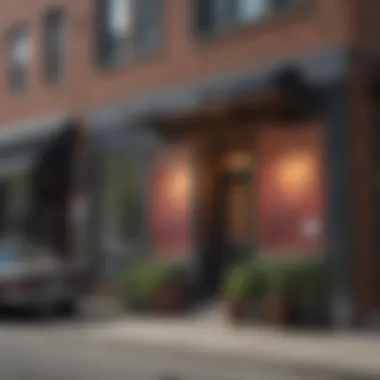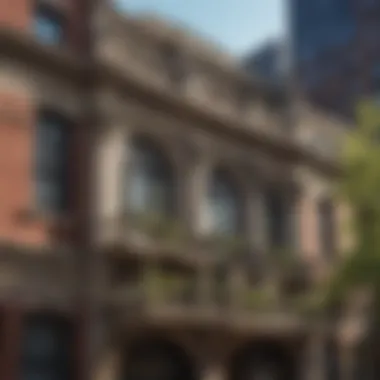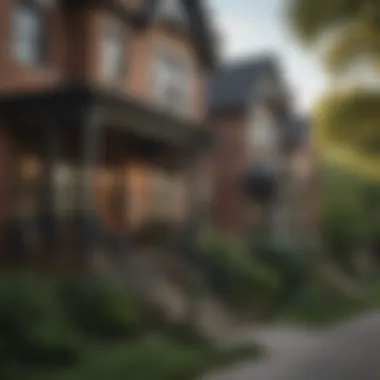Exploring Chicago's Best Neighborhoods for Living


Intro
Chicago is a city of neighborhoods, each with its own distinct flavor and character. Understanding the essence of these areas can be quite enlightening for anyone interested in the real estate market, urban living, or simply the cultural tapestry of the city. This article aims to provide a detailed examination of a selection of neighborhoods in Chicago, illuminating the various factors that define their unique appeal.
From the architectural marvels that grace the streets to the rich historical context that weaves through every block, our exploration taps into the numerous dimensions that make Chicago a vibrant urban hub. By categorizing neighborhoods based on cultural significance and lifestyle offerings, readers will gain insight into what makes each area special.
Whether you are a potential resident or a design enthusiast, this guide will help you navigate the multifaceted urban landscape of Chicago. With its combination of historic districts and modern enclaves, each neighborhood carries a narrative that enhances the greater story of this city.
Exquisite Architectural Designs
Exploring the architectural designs in Chicago’s neighborhoods reveals a treasure trove of inspiration for enthusiasts. The city's skyline includes a diverse compilation of styles, from stunning vintage buildings to sleek modern structures.
Unique Home Features
In areas like Lincoln Park and Lakeview, you can find remarkable homes characterized by intricate facades and elaborate details. Features such as:
- Ornate cornices and moldings
- Expansive windows that bring in natural light
- Unique balcony designs that invite outdoor living
Each feature contributes to the full experience of living in these neighborhoods, capturing a sense of history and modernity.
Historical Significance
Many neighborhoods date back several decades, some to as early as the mid-19th century. For instance, the historic district of Pullman is recognized not only for its stunning architecture but also for its role in labor history.
Understanding the historical context helps to appreciate architectural styles. Neighborhoods like Hyde Park showcase variations from Gothic to Art Deco influences, reflecting the changing times in Chicago’s expansive landscape.
"Chicago is not just an architectural hub but a narrative built through time, telling the stories of its people through every building."
Interior Decorating Tips
Creating a welcoming and stylish home in any Chicago neighborhood can be achieved with thoughtful interior design. Understanding space and color can drastically change the ambiance of both old and new properties.
Color Schemes and Trends
The importance of color in design cannot be overstated. Certain trends have emerged that resonate well with the architectural integrity of these neighborhoods. Soft hues such as:
- Pastel greens
- Warm beige
- Bold navy accents
These colors can coincide beautifully with traditional and modern designs alike, offering a refined yet inviting environment.
Space Optimization Techniques
In urban settings, space is often limited. Therefore, clever utilization becomes essential. Techniques such as:
- Multi-functional furniture
- Vertical storage options
- Open floor plans
These strategies maximize livable space while maintaining a clean aesthetic.
In summary, understanding Chicago's neighborhoods is more than just knowing their locations; it is about immersing oneself in their unique identities and cultural significance. This knowledge fosters a greater appreciation for Chicago's urban landscape.
Prolusion
The neighborhoods of Chicago create a rich mosaic, each piece contributing to the urban experience of the city. Exploring these neighborhoods unveils their individual narratives, which often reflect the historical, cultural, and architectural diversities present within the metropolis. This article aims to clarify the significance of this exploration, emphasizing the unique character and opportunities each community provides.
Understanding Chicago's Urban Landscape


Chicago's urban landscape is a complex web that consists of over seventy neighborhoods, each with its own identity. The city’s layout reflects a mix of historical developments and modern growth patterns, shaped by factors such as immigration, industry, and urban planning. Visiting neighborhoods like Pilsen or Hyde Park offers insights into Chicago's diverse origins and the ongoing evolution of its community spirit. Every area tells its story through the architecture of its buildings, the vibrancy of its streets, and the voices of its residents.
Geographically, the neighborhoods range from the sprawling parks in Lincoln Park to the art-laden blocks of Wicker Park. Navigating through these areas not only enhances understanding of the city's history but also allows appreciation for how residents have adapted their environments to meet their needs over time. Recognizing this urban landscape is essential for anyone considering life or investment in Chicago.
Importance of Neighborhood Choice
Selecting a neighborhood is a crucial decision for many individuals and families. The significance of this choice lies in various elements: lifestyle, accessibility, and community identity. Each neighborhood offers a distinct blend of amenities, cultural activities, and social interactions. For instance, families may prefer a community like Mason Park for its family-oriented environment, while young professionals might gravitate towards the vibrant scene in River North.
Moreover, the process of choosing a neighborhood can have lasting implications. Factors such as proximity to work, quality of schools, and local recreational facilities are vital considerations. Engaging with neighborhood-specific characteristics helps in making informed decisions, ensuring a place where one can thrive in both work and personal life. Ultimately, this choice shapes experience, satisfaction, and connection to the city.
The neighborhoods one chooses can foster a sense of belonging and community, crucial for a fulfilling urban experience.
Cultural Districts
Cultural districts in Chicago serve as vibrant representations of the city’s rich ethnic history and diversity. They encompass distinct areas where specific cultural heritages thrive. Understanding these neighborhoods enriches one's perspective on Chicago as a dynamic urban center. From art to cuisine, these districts offer unique experiences that appeal to both residents and visitors alike.
The importance of cultural districts must not be understated. They provide an opportunity to explore and appreciate the contributions of different communities to the overall tapestry of the city. Engaging with these neighborhoods highlights local customs, traditions, and, in many cases, the struggles and triumphs of the communities that inhabit them.
Pilsen: A Hub of Mexican Heritage
Pilsen stands out as a notable cultural district, renowned for its deep ties to the Mexican community. The area was historically settled by Eastern Europeans and later transformed by an influx of Mexican immigrants in the 20th century. Today, Pilsen is characterized by its bright murals, which reflect Mexican culture and history. These street art pieces are not just visually striking but also narrate the stories of the community.
Several cultural institutions enrich Pilsen's landscape. The National Museum of Mexican Art is pivotal. It showcases both historic and contemporary works, offering deeper insight into Mexican artistic traditions. Each year, Pilsen also hosts the renowned Day of the Dead celebration. This event attracts visitors from across the city, further establishing Pilsen's standing as a cultural hub.
In addition, Pilsen’s culinary scene cannot be overlooked. Tacos, tamales, and authentic churros are prevalent throughout the neighborhood. Unique local eateries such as Carnitas Uruapan and Los Comales draw food enthusiasts, illustrating the area’s vibrant culinary life.
Hyde Park: The Intellectual Center
Hyde Park is often associated with academia, largely due to the presence of the University of Chicago. This institution profoundly influences the neighborhood’s culture and atmosphere. As a gathering place of scholars and students, Hyde Park has cultivated a community that prioritizes education and intellectual discourse.
The architectural landscape of Hyde Park consists of stunning historic buildings. This area features a mix of Gothic and modern architecture, reflecting the neighborhood's evolution over time. Notable sites include the Robie House, designed by Frank Lloyd Wright, which draws architecture students and enthusiasts.
Hyde Park also offers a plethora of cultural events. From global music festivals held in local parks to art exhibitions at the Smart Museum of Art, the district provides an ongoing engagement with art and culture. Coffee shops and bookstores add to the intellectual ambiance, where residents often gather to exchange ideas or work on projects.
Little Italy: A Taste of Tradition
Little Italy is another noteworthy cultural district, showcasing its rich Italian-American heritage. Historically, the neighborhood provided refuge to Italian immigrants in the late 19th and early 20th centuries. Today, it remains a charming area, celebrated for its culinary offerings and vibrant community spirit.
The district is peppered with family-owned restaurants like Fabiano's Pizzeria and Portillo's, offering traditional Italian dishes. These establishments preserve recipes passed down through generations, making meals an authentic experience.
Little Italy is also home to various cultural festivals, such as the Feast of San Giuseppe. These events not only celebrate Italian culture but also reinforce community bonds, drawing crowds together to partake in food, music, and traditions.
Architectural Highlights
Architectural highlights play a significant role in defining the character and appeal of Chicago's neighborhoods. The skyline of Chicago is a reflection of its rich history, diverse cultures, and ongoing evolution. Each neighborhood showcases its architectural style, contributing to the city's unique identity.
When analyzing neighborhoods, understanding architectural highlights is essential for several reasons:
- Cultural Significance: Architecture often embodies the cultural narratives of a community. Historic buildings reveal stories from different eras, while modern structures represent contemporary values.
- Investment Potential: Unique architecture can enhance property value. Areas with distinctive design often attract buyers and investors, making them financially appealing.
- Lifestyle Compatibility: Architectural styles influence the lifestyle within neighborhoods. High-rise condos cater to urban dwellers, while historic single-family homes attract families seeking more space.
Each highlighted neighborhood represents not just a place to live, but a canvas where history, culture, and modernity coexist seamlessly.
Lincoln Park: Historic Charm Meets Modern Living
Lincoln Park stands out as an area where historic charm intertwines effortlessly with modern living. Known for its lush parks, the neighborhood hosts beautiful Victorian brownstones and contemporary condominiums. The preservation of its historical architecture is coupled with new developments that enhance its appeal.
Residents enjoy a vibrant community, where access to the Lincoln Park Zoo and the lakefront is a considerable advantage. An array of restaurants and boutiques further enrich the living experience here, making it appealing for families and young professionals alike.


Overall, Lincoln Park is a prime example of how a neighborhood can maintain its character while accommodating the needs of modern-day residents.
Bucktown and Wicker Park: The Blend of Art and Architecture
Bucktown and Wicker Park are neighboring areas known for their eclectic architecture and thriving arts scene. Cobblestone streets lined with 19th-century buildings set the backdrop for an artistic vibe. This region features both rehabilitated historic sites and innovative new constructions that reflect the spirit of creativity.
Art galleries and studios thrive alongside cutting-edge cafes and shops. This blend attracts a diverse population, from artists to families. The area fosters a strong community ambiance, where creativity enhances the living experience.
Moreover, the architectural diversity here supports a sense of individuality. Each building tells a story, inviting residents to be part of its evolving narrative.
The Gold Coast: Luxury and Elegance
The Gold Coast exemplifies sophistication and luxury, marked by its stunning high-rises and historic mansions. This area is synonymous with elegance, attracting affluent residents seeking a prestigious lifestyle. The architectural styles range from neo-classical to contemporary designs, showcasing Chicago’s architectural heritage.
Residents in the Gold Coast enjoy proximity to high-end shopping on Oak Street, fine dining, and cultural institutions such as the Museum of Contemporary Art. The well-kept streets and upscale ambiance create an enticing environment for those valuing luxury.
The Gold Coast not only represents architectural splendor but also reflects the lifestyle of its inhabitants. With a focus on exclusive living and high-end amenities, it remains a coveted neighborhood in the city.
"Architecture is the thoughtful making of space, and Chicago’s neighborhoods provide endless inspiration for how we inhabit our environment."
The architectural highlights in Chicago's neighborhoods reveal much about the city's identity. From historic properties to modern designs, each area offers unique advantages that cater to a diverse demographic.
Understanding these architectural attributes aids prospective residents in choosing the ideal neighborhood that reflects their lifestyle and values.
Lifestyle and Amenities
The lifestyle and amenities offered by different neighborhoods can significantly influence the experience of living in Chicago. Various factors come into play when considering where to reside, such as access to recreational areas, cultural spots, and daily conveniences. Understanding these elements helps potential residents make informed decisions about their ideal living conditions.
Living in a neighborhood with well-developed amenities often reflects positively on quality of life. Access to parks, restaurants, shopping, and public transport plays a crucial role. Convenience directly impacts a resident's daily routine and overall satisfaction. Chicago’s neighborhoods vary widely in lifestyle offerings, making it essential to identify which attributes are most important to you.
River North: Art, Dining, and Nightlife
River North is known for its vibrant atmosphere filled with art galleries, upscale dining options, and an exciting nightlife. This neighborhood is home to numerous art institutions, such as the Museum of Contemporary Art. Strolling through its streets, one can experience a lively mix of local and international culture. The variety of bars, lounges, and restaurants ensures that residents have ample options for entertainment.
Residents benefit from proximity to the Chicago River, making it easy to enjoy waterfront activities or simply relax by the riverbank. Well-connected through public transportation, River North caters to those wanting quick access to downtown attractions and the Loop.
South Loop: The Emerging Neighborhood
South Loop is rapidly becoming a popular choice for both young professionals and families. Its blend of historic sites and modern developments creates a unique urban living experience. The area has experienced significant growth in recent years, leading to an influx of new restaurants and retail spaces, which contributes to its emerging status.
Key features of South Loop include its close proximity to museums, parks, and major sporting venues. The presence of public transport options, including train lines, makes commuting to other parts of the city practical. With a diverse community and increasing amenities, South Loop stands out as a compelling choice for Chicago newcomers.
Andersonville: A Community-Focused Environment
Andersonville emphasizes a strong sense of community, making it ideal for families and individuals seeking connection. Its tree-lined streets and charming storefronts create a welcoming atmosphere. This neighborhood hosts a number of local events and markets, further fostering community ties among residents.
A highlight of Andersonville is its dining scene, with a rich variety of cafes and restaurants, many featuring locally sourced ingredients. The emphasis on sustainability and support for small businesses resonates with those who value a community-focused lifestyle. Parks and green spaces offer opportunities for recreation, appealing to families and nature lovers alike.
"Choosing the right neighborhood can enrich your living experience and enhance your connection to the city."
With these lifestyles and amenities in mind, it’s clear how integral they are to the urban experience in Chicago. Each neighborhood presents distinct offerings that cater to different preferences, making it essential to choose one that aligns with individual needs.
Family-Friendly Neighborhoods
Family-friendly neighborhoods hold significant value in Chicago's diverse urban environment. These areas cater to the unique needs of families, providing a blend of safety, community, and access to essential amenities. In recent years, more people prioritize features such as access to parks, schools, and recreational activities when choosing where to live. This section explores two neighborhoods in Chicago that exemplify these qualities: Mason Park and Evanston.


Mason Park: A Family-Oriented Community
Mason Park stands out as a true haven for families. This neighborhood focuses on community and connection, making it easy for families to integrate into the area. Numerous parks create safe spaces for children to play, including Mason Park itself, which fosters a sense of belonging among residents.
Families also benefit from good schools in and around Mason Park. The local schools often receive positive ratings, helping parents feel confident about their children's education. In addition to great educational institutions, the neighborhood also offers various family-friendly events that promote social interaction among residents.
Overall, Mason Park provides an environment conducive to child-rearing, complete with playgrounds, community facilities, and programs tailored for families.
Evanston: Suburb Charm with City Access
Evanston combines suburban charm with proximity to urban conveniences. Located just north of Chicago, it offers families a quieter atmosphere while remaining well-connected to the city. The area features tree-lined streets and historical homes, giving it a welcoming and serene feel.
Evanston's family-friendly attributes include excellent public schools and a variety of extracurricular activities. Parents often appreciate the robust educational opportunities available, both in academics and athletics. In addition to schools, the neighborhood has ample parks and community spaces where families can gather.
Moreover, Evanston hosts local events year-round. These gatherings encourage families to engage with their community while enjoying what the area has to offer. Access to the lakefront adds another layer of appeal, providing families with recreational opportunities and beautiful views.
Overall, both Mason Park and Evanston are exemplary neighborhoods for families seeking a supportive environment with accessible amenities. Residents can enjoy the best of both worlds, combining family-friendly living with the richness of Chicago's vibrant urban atmosphere.
Emerging Neighborhoods
Emerging neighborhoods in Chicago signify areas witnessing revitalization and growth. They play a crucial role in the city’s overall evolution. As people seek affordability, creativity, and culture, these neighborhoods become attractive options for new residents. The shift often leads to a renaissance in local businesses, creative industries, and community engagement. Furthermore, the housing market sees increased interest, making it key for real estate enthusiasts. By delving into these neighborhoods, potential residents can find promising opportunities.
Logan Square: Eclectic and Evolving
Logan Square is a neighborhood that embodies eclecticism. It attracts a diverse mix of residents. The blend of vintage architecture and contemporary developments creates a unique environment. Streets lined with murals reflect the area's artistic spirit. Local parks, such as Logan Square Park, invite outdoor activities and community events.
The neighborhood's dining scene is notable. Restaurants serve a variety of cuisines, emphasizing local ingredients.
"Logan Square represents the future of urban living, merging tradition with innovation."
The availability of public transportation ensures easy access to the rest of the city. This practicality boosts its appeal among young professionals and families alike. Furthermore, the growth of small businesses shows the potential for economic development. As such, Logan Square is not just a residential area; it is a vibrant community.
Bridgeport: A Blend of Cultures
Bridgeport stands out for its cultural diversity. Historically, it was home to various immigrant communities, which enriches its cultural fabric today.
The neighborhood is characterized by a blend of architectural styles. From classic Chicago bungalows to modern condos, there's something for everyone. This diversity mirrors the community's welcoming nature.
Bridgeport has several parks that cater to families and individuals. Additionally, the community celebrates its heritage through local events and festivals. This collective spirit contributes to a robust neighborhood identity.
Dining options reflect the cultural influences present. Authentic ethnic cuisine can be found alongside trendy cafes. This combination draws in food lovers and supports local businesses.
Understanding Bridgeport's significance also lies in its proximity to downtown. As the neighborhood continues to develop, it attracts a younger demographic looking for that balance of culture and convenience.
Closure
The conclusion of this article holds significant weight regarding the exploration of Chicago's neighborhoods. It brings together the insights gathered from each section, allowing for a holistic view of the city's diverse offerings. Understanding neighborhood dynamics is essential for anyone considering a move, investment, or even a visit to these areas.
Reflecting on Neighborhood Choices
When reflecting on neighborhood choices, it’s crucial to consider factors that align with personal lifestyles and preferences. Each neighborhood in Chicago offers a distinct atmosphere, influenced by culture, architecture, and amenities. For instance, families might prioritize schools and parks, while young professionals may lean towards vibrant nightlife and cultural events.
- Cultural Fit: Each of Chicago's neighborhoods reflects a unique cultural identity. An area like Pilsen resonates strongly with the Mexican heritage, while Hyde Park appeals to intellectual pursuits. This cultural vibrance adds to the quality of life and community cohesion.
- Living Environment: The type of housing and design within each neighborhood varies significantly. From vintage brownstones in Lincoln Park to modern high-rises in River North, options abound, catering to diverse preferences.
- Accessibility and Community: Consider how each neighborhood connects to the rest of the city through public transport and walkability. Neighborhoods like South Loop offer close proximity to downtown, which is attractive for commuters and urban explorers alike.
Chicago's Neighborhoods: A Continuous Journey
The neighborhoods of Chicago represent a continuous journey. They evolve and adapt to changing demographics, socio-economic factors, and urban planning initiatives. Observing this evolution can provide insight into real estate trends and future developments. Every visit reveals new art installations, the opening of new restaurants, or even the transformation of spaces within these districts.
- Growth and Development: Investing time in understanding these neighborhoods offers real estate enthusiasts a first-hand look at market fluctuations and potential growth spots. Emerging neighborhoods like Logan Square and Bridgeport illustrate how shifts in culture can influence property values and lifestyles.
- Community Engagement: Neighborhoods foster community engagement through events, local markets, and festivals. Engaging with these activities enriches the understanding of community nuances and connections.
- The Journey Ahead: As Chicago continues to grow, its neighborhoods will reflect the changes within society. Keeping a pulse on these shifts will enhance one’s appreciation and understanding of what makes Chicago unique.
"The neighborhoods in Chicago are not just locations; they are stories waiting to be told, constantly evolving and reshaping the city's identity."
As a final note, exploring Chicago's neighborhoods is more than just a geographical venture. It is about connecting with the essence of the city and appreciating how these unique identities interweave to create a rich tapestry of urban life.















